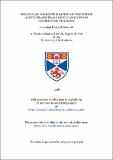Molecular characterisation of the serine acetyltransferase gene-family from 'Arabidopsis thaliana'
Abstract
Formation of L-cysteine, from L-serine and sulphide, represents the principal route of Sulphur incorporation into organic compounds in living organisms. Cysteine biosynthesis in plants is achieved by two enzymes, serine acetyltransferase (SAT) and 0-acetylserine (thiol) lyase (OASTL), which form a cysteine synthase complex. Three novel cDNA species, Sat-52, Sat-53 and Sat-106, encoding SAT isoforms from A. thaliana were isolated from a collection of cDNAs previously cloned by functional complementation of the E. coli cysE mutant strain JM15, which is defective in serine acetyltransferase. Deduced amino acid sequence analysis suggests that Sat-52 encodes a putatively mitochondrial isoform whilst Sat-53 and Sat-106 encode proteins with cytoplasmic locations. Sequence information derived from the Arabidopsis Genome Initiative allows mapping of Sat-52, Sat-53 and Sat-106 genes to locations on chromosomes V, I and II respectively. A fourth SAT cDNA from A. thaliana, Sat-1, was cloned prior to the work detailed here and encodes a putatively plastidic isoform of the enzyme. Southern hybridisation against digested genomic DNA suggests that each SAT gene is represented by a single copy in the A. thaliana genome. DNA probes specific to the SAT gene-family members were designed and used in various studies to examine expression of SAT genes. Northern blotting and hybridisation was used to determine transcript distribution between root, leaf, stem, flower and silique tissues and to study the expression of the gene-family in response to sulphate and nitrate nutrition. Spatial distribution of Sat-52 and Sat- 53 transcript in root, leaf and stem tissue was also examined by in situ hybridisation using specific riboprobes. Both genes are highly expressed in leaf trichomes. The Sat-52 transcript was also localised to the vascular- bundles of root, leaf and stem tissue. The isoforms encoded by Sat-52 and Sat-53 are hypothesised to have specific roles in these cell-types.
Type
Thesis, PhD Doctor of Philosophy
Collections
Items in the St Andrews Research Repository are protected by copyright, with all rights reserved, unless otherwise indicated.

